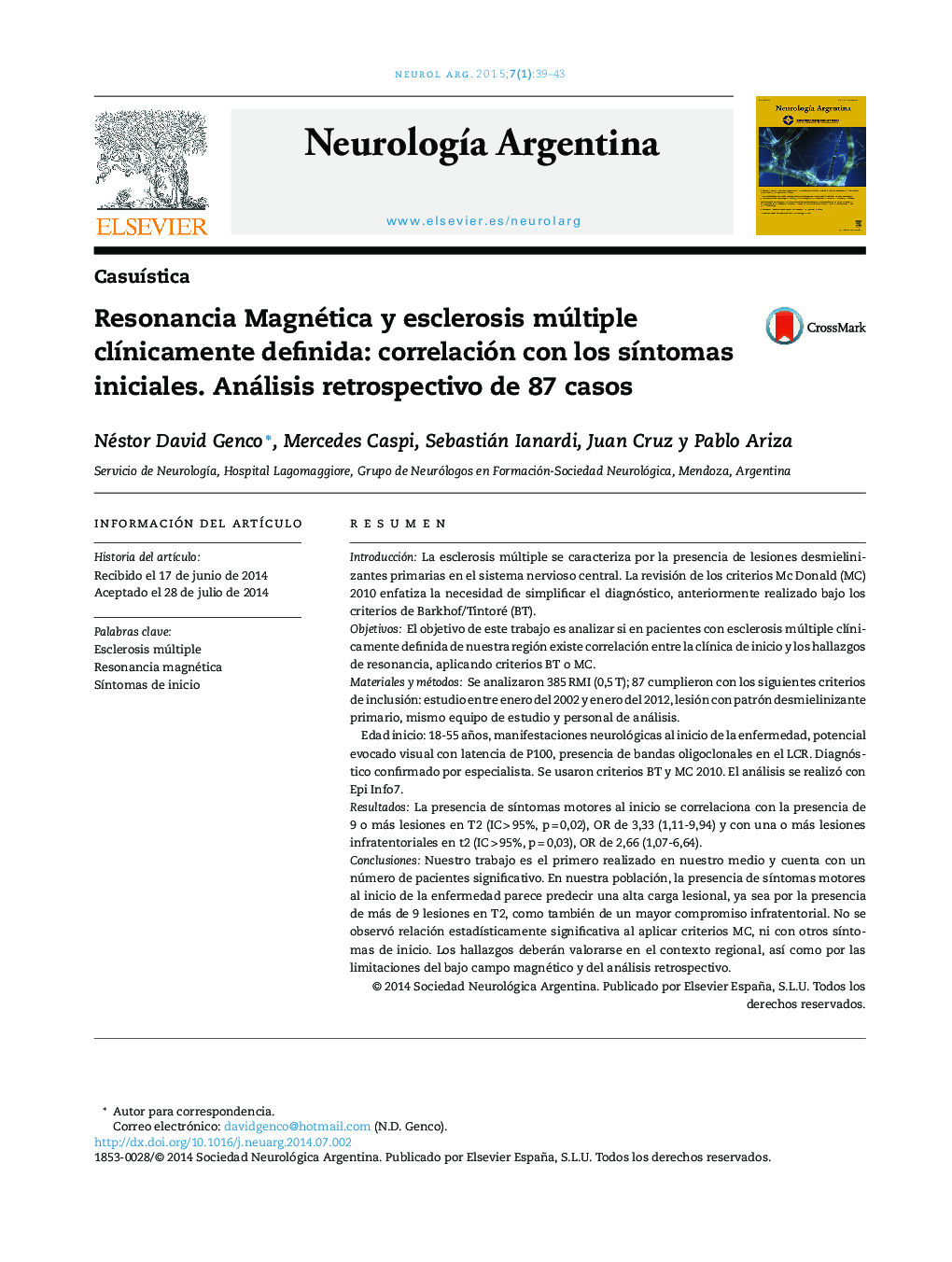| Article ID | Journal | Published Year | Pages | File Type |
|---|---|---|---|---|
| 3076682 | Neurología Argentina | 2015 | 5 Pages |
ResumenIntroducciónLa esclerosis múltiple se caracteriza por la presencia de lesiones desmielinizantes primarias en el sistema nervioso central. La revisión de los criterios Mc Donald (MC) 2010 enfatiza la necesidad de simplificar el diagnóstico, anteriormente realizado bajo los criterios de Barkhof/Tintoré (BT).ObjetivosEl objetivo de este trabajo es analizar si en pacientes con esclerosis múltiple clínicamente definida de nuestra región existe correlación entre la clínica de inicio y los hallazgos de resonancia, aplicando criterios BT o MC.Materiales y métodosSe analizaron 385 RMI (0,5 T); 87 cumplieron con los siguientes criterios de inclusión: estudio entre enero del 2002 y enero del 2012, lesión con patrón desmielinizante primario, mismo equipo de estudio y personal de análisis.Edad inicio: 18-55 años, manifestaciones neurológicas al inicio de la enfermedad, potencial evocado visual con latencia de P100, presencia de bandas oligoclonales en el LCR. Diagnóstico confirmado por especialista. Se usaron criterios BT y MC 2010. El análisis se realizó con Epi Info7.ResultadosLa presencia de síntomas motores al inicio se correlaciona con la presencia de 9 o más lesiones en T2 (IC > 95%, p = 0,02), OR de 3,33 (1,11-9,94) y con una o más lesiones infratentoriales en t2 (IC > 95%, p = 0,03), OR de 2,66 (1,07-6,64).ConclusionesNuestro trabajo es el primero realizado en nuestro medio y cuenta con un número de pacientes significativo. En nuestra población, la presencia de síntomas motores al inicio de la enfermedad parece predecir una alta carga lesional, ya sea por la presencia de más de 9 lesiones en T2, como también de un mayor compromiso infratentorial. No se observó relación estadísticamente significativa al aplicar criterios MC, ni con otros síntomas de inicio. Los hallazgos deberán valorarse en el contexto regional, así como por las limitaciones del bajo campo magnético y del análisis retrospectivo.
IntroductionMultiple sclerosis is characterized by the presence of primary demyelinating lesions in the central nervous system. The revised McDonald criteria (MC) 2010 emphasize the need to simplify the diagnosis, previously performed under the criteria of Barkhof/Tintoré (BT).ObjectivesThe aim of this paper is to analyze whether patients with CDMS in our region correlation between clinical onset and MRI findings, applying criteria BT or MC.Materials and methodsWe analyzed 385 MRI (0.5 T). 87 met the following inclusion criteria: study between January 2002 - January 2012, primary demyelinating lesion pattern, same team of personal study and analysis, starting age: 18-55 years, neurological manifestations at onset of disease, visual evoked potential P100 latency, presence of CSF oligoclonal bands. Diagnosis confirmed by specialist. There were used BT and MC 2010 criteria. The analysis was realized by Epi Info7.ResultsThe presence of the start motor symptoms correlates with the presence of 9 or more lesions in t2 (IC > 95%, P=.02), OR of 3.33 (1.11 to 9.94) and with one or more infratentorial lesions in t2 (CI > 95%, P=.03), OR 2.66 (1.07 to 6.64).ConclusionsOur study is the first conducted in our environment, and has a significant number of patients. In our population, the presence of motor symptoms at onset of the disease seems to predict high lesion load, either by the presence of more than 9 T2 lesions, as well as a greater commitment infratentorial. No statistically significant relationship was observed when applying MC criteria or other symptoms start. The findings should be valued in the regional context, as well as by the limitations of low magnetic field and retrospective analysis.
